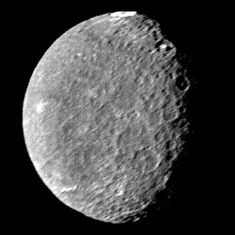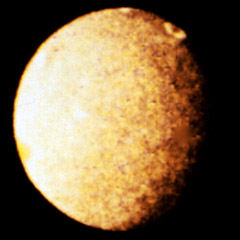Our Solar System
Umbriel

Umbriel [UM-bree-ul] is the thirteenth of Uranus' moons and the third largest. Umbriel was discovered by William Lassell in 1851. Since then it has been visited by one spacecraft, Voyager 2, which taught us nearly everything we know about this moon.
The Fluorescent Cheerio

As with all of Uranus' moons, Umbriel is believed to be composed of about 50% water ice and 50% rocky material. This composition is very similar to Saturn's moon, Rhea, but with a larger percentage of rock. Umbriel is about the same size as Ariel and has nearly the same density. The most curious feature of Umbriel is a bright, ring-shaped area near to top of the moon. It has been called the "fluorescent cheerio" because of its round shape and bright color. This feature is believed to be floor of a crater. The impact that formed the crater may have exposed material from deeper in the moon's crust that has a different albedo from the surrounding dark material.
Features of Umbriel

Umbriel is an extremely dark moon. It reflects only about half as much light as Uranus' brightest moon, Ariel. Astronomers are not sure what accounts for Umbriel's dark color. The cratered surface of this moon is relatively featureless. This indicates that it has probably been geologically stable since its formation billions of years ago. Some of the craters are much brighter than the surrounding areas. As with the "fluorescent cheerio", these bright areas are believed to have been formed when recent impacts brought lighter material to the surface. Umbriel has no known atmosphere and no magnetic field.
Statistics of Umbriel
Discovered by - William Lassell
Year of Discovery - 1851
Diameter - 727 miles (1, 170 km)
Mean Distance from Uranus - 165,223 miles (265,970 km)
Rotational Period - 4.14 Days
Orbital Period - 4.14 Days
Orbital Eccentricity - 0.005
Orbital Inclination - 0.36 degrees
Main Atmospheric Component - None
Apparent Magnitude - 14.81
Year of Discovery - 1851
Diameter - 727 miles (1, 170 km)
Mean Distance from Uranus - 165,223 miles (265,970 km)
Rotational Period - 4.14 Days
Orbital Period - 4.14 Days
Orbital Eccentricity - 0.005
Orbital Inclination - 0.36 degrees
Main Atmospheric Component - None
Apparent Magnitude - 14.81
